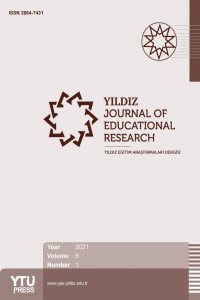Turkish EFL Learners’ Use of English Collocations
Turkish EFL Learners’ Use of English Collocations
L2 learners’ competence in collocations has drawn increased attention in the field of second/ foreign language acquisition in the last few decades. Yet, further research in different language learning contexts is needed to expand on our knowledge of L2 learners’ collocation attainment. Based on a small-scale cross-sectional study, this study explores the amount and types of English collocations which Turkish pre-intermediate and advanced L2 learners utilized in their in-class writings. The study also intends to identify the mistakes learners made when they produced English collocations. Furthermore, it investigates the influence of the learners’ L1 on the production of L2 collocations. The results showed that the learners’ proficiency level was a critical dynamic determining the amount of L2 collocations produced accurately in essays. The results also revealed that the L1 influence on the production of L2 collocations existed in both pre-intermediate and advanced learners although it varied with the learners’ overall L2 proficiency and with the type of collocation. The study emphasizes the importance of improving EFL learners’ collocational competence in EFL classes to foster their fluent language use in English.
___
- Alexander, R. L. (1984). Fixed expressions in English: reference books and the teacher. ELT Journal, 38(2), 127-134.
- Al-Zahrani, M. S. (1998). Knowledge of English lexical collocations among male Saudi college students majoring in English at a Saudi university. [Unpublished doctoral dissertation]. Indiana University of Pennsylvania.
- Balcı, Ö. & Çakır, A. (2012). Teaching vocabulary through collocations in EFL Classes: The case of Turkey. International Journal of Research Studies in Language Learning, 1(1), 21-32.
- Bahn, J. (1993). Lexical collocations: A contrastive view. ELT Journal, 47(1), 56-63. Bahns, J. & Eldaw, M. (1993). Should we teach EFL students collocations?. System 21(1), 101-114.
- Benson, M., Benson, E., Ilson, R. (1986a). The BBI combinatory dictionary of English: A guide to word combinations. Amsterdam: John Benjamins.
- Benson, M., Benson, E., Ilson, R. (1986b). Lexicographical description of English. Amsterdam: John Benjamins.
- Carter, R. (2006). What is advanced-level vocabulary? The case of chunks and clusters. In C. Coombe (Ed.), Words Matter: The importance of vocabulary in English language teaching and learning (pp. 23-41). Alexandria, Va: TESOL.
- Carter, R. & McCarthy, M. (1988). Vocabulary and language teaching. Essex: Longman.
- Chen, M. (2008). A study of the English collocation competence of college students in Taiwan. [Unpublished master’s thesis]. Taiwan University of Science and Technology.
- Fan, M. (2009). An exploratory study of collocational use by ESL students –A task based approach. System, 37, 110-123.
- Gorgis, D. T. & Al-Kharabsheh, A. (2009). The translation of Arabic collocations into English: Dictionary-based vs. dictionary-free measured knowledge. Linguistik Online, 37, 21-33.
- Howarth, P.(1998). Phraseology and second language proficiency. Applied Linguistics, 19(1), 24-44.
- Jobbins, A. C. & Evett, L. J. (1998) Text segmentation using reiteration and collocation. 614-618. Retrived December 21, 2020 from https://www.aclweb.org/anthology/C98-1097.pdf.
- Kasuya, M. (2008).Teaching collocation in Japanese classrooms. 1-16. Retrieved December 21, 2020 from https://citeseerx.ist.psu.edu/viewdoc/download?doi=10.1.1.138.8395&rep=rep1&type=pdf.
- Kennedy, G. (2000). An introduction to corpus linguistics. Beijing: Foreign Language Teaching and Research Press.
- Kenndey, G. (2003). Amplifier collocations in the British national corpus: Implications for English language teaching. TESOL QUARTERLY, 37(3), 467-487.
- Keshavarz, M. H. & Salimi, H. (2007). Collocational competence and cloze test performance: A study of Iranian EFL learners. International Journal of Applied Linguistics,17(1), 81-92.
- Koosha, M. & Jafarpour, A. A. (2006). Data-driven learning and teaching collocation of prepositions: The case of Iranian EFL adult learners. Asian EFL Journal, 8, 192-210.
- Hatice Özata Levin, K. A. (2006). Study design III: Cross-sectional studies. Evidence-Based Dentistry, 7, 24-25.
- Leśniewska, J. (2006). Collocations and second language use. Studia Linguistica, 95-105. Retrieved February 8, 2021 from https://filg.uj.edu.pl/documents/41616/4333138/12306-Lesniewska.pdf.
- Lewis, M. (Ed.). (2000). Teaching collocation: Further developments in the lexical approach. London: Language Teaching Publications.
- Lindstromberg, S. & Boers, F. (2008). Teaching chunks of language. Cambridge: Cambridge University Press.
- Mahmoud, A. (2005). Collocation errors made by Arab learners of English. Asian EFL Journal Press. The Professional Teacher Articles, 5. 117-126. Retrieved January 18, 2021 from https://www.asian-efl-journal.com/monthly-editions- new/collocation-errors-made-by-arab-learners-of-english/.
- Men, H. (2018). Vocabulary increase and collocation learning: A corpus-based cross- sectional study of Chinese learners of English. Singapore: Springer.
- Nattinger, F. (1988). Some current trends in vocabulary teaching. In R. Carterm & M. McCarthy (Eds.), Vocabulary and language teaching. London (pp.62-82). Longman.
- Nesselhauf, N. (2003). The use of collocations by advanced learners of English and some implications fro teaching. Applied Linguistics, 24 (2), 223-242.
- Rahimi, M. & Momeni, G. (2012). The effect of teaching collocations on English language proficiency. Procedia - Social and Behavioral Sciences 31, 37-42. Richards, J., Schmidt, R., Platt, H. &
- Schmidt, M. (2002). Dictionary of language teaching and applied Linguistics. Essex: Longman.
- Shin, D. & Nation, P. (2007). Beyond single words: the most frequent collocations in spoken English. ELT Journal, 62(4), 339-348.
- Taiwo, R. (2004). Helping ESL learners to minimize collocational errors. The Internet TESL Journal, 10(4), Retrieved December 15, 2020 from http://iteslj.org/Techniques/Taiwo-Collocation.html.
- V asiljevic, Z. (2008). Developing collocational competence of second language learners. The EastAsian Learner, 4 (1), 46-50.
- Vasiljevic, Z. (2014). Teaching collocations in a second language: Why, what and how?. ELTA Journal, 2(2). 48-73.
- Youmei, Y . & Y un. Z. (2005). A tentative corpus-based study of collocations acquisition by Chinese English language learners. Canadian Social Science, 2(2), 105-113.
- ISSN: 2564-7431
- Başlangıç: 2016
- Yayıncı: Yıldız Teknik Üniversitesi
